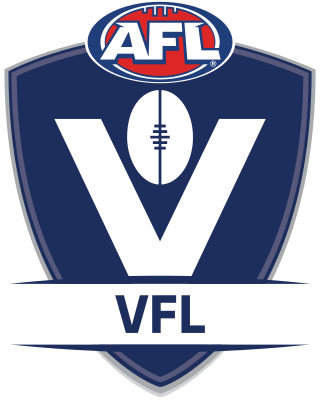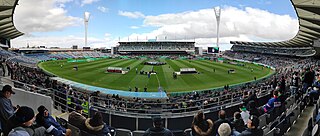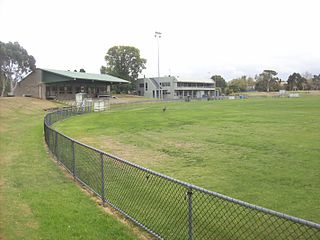Related Research Articles

The Victorian Football League (VFL) is an Australian rules football league in Australia serving as one of the second-tier regional semi-professional competitions which sit underneath the fully professional Australian Football League (AFL). It includes teams from clubs based in the eastern states of Australia: Victoria, New South Wales and Queensland, and includes reserves teams for the east coast AFL clubs.

Kardinia Park is a sporting and entertainment venue located within Kardinia Park, South Geelong, in the Australian state of Victoria. The stadium, which is owned and operated by the Kardinia Park Stadium Trust, is the home ground of AFL club Geelong Football Club and A-League club Western United. The capacity of Kardinia Park is 36,000, making it the largest-capacity Australian stadium in a regional city.

The Coburg Football Club, nicknamed the Coburg Lions, is an Australian rules football club based in Coburg, a northern suburb of Melbourne, and currently playing in the Victorian Football League (VFL). It is based at Coburg City Oval since 1915, which was partly redeveloped in 2020. Coburg has historically been a proud club and has won 6 VFA/VFL premierships with the most recent premiership in 1989. From 2001 to 2013 the club was aligned with the Richmond Football Club in the Australian Football League (AFL), acting as its reserves team. As of 2014, Coburg is a stand-alone club in the Victorian Football League (VFL).

Corio Oval was an Australian rules football ground, located in Geelong, Victoria, and used by the Geelong Football Club in the VFA and the VFL from 1878 to 1915, and 1917 to 1940. Sited in Eastern Park, the oval was served by trams from 1930 when the line was extended along Ryrie Street to the football ground.

Yarraville Football Club was an Australian rules football club founded in 1903 and played in the VJFA until 1927. In 1928, the club joined the Victorian Football Association where it played until 1984 when the club went into recess. In 1996, the Kingsville Football Club in the Western Region Football League who by this time had taken over the Yarraville ground changed their name to Yarraville. In 2007 the Yarraville Football Club merged with the Seddon Football Club to become the Yarraville Seddon Eagles.

The 1925 VFL season was the 29th season of the Victorian Football League (VFL), the highest level senior Australian rules football competition in Victoria.
The 1941 VFL season was the 45th season of the Victorian Football League (VFL), the highest level senior Australian rules football competition in Victoria. The season featured twelve clubs, ran from 26 April until 27 September, and comprised an 18-game home-and-away season followed by a finals series featuring the top four clubs.

The 1944 VFL season was the 48th season of the Victorian Football League (VFL), the highest level senior Australian rules football competition in Victoria.
Brunswick Football Club was an Australian rules football club which played in the Victorian Football Association (VFA) from 1897 until 1991. Based in Brunswick, Victoria, for most of their time in the Association they were known as the Magpies, and wore black and white guernseys. In its final two seasons in the VFA, it was known as Brunswick-Broadmeadows.
Northcote Football Club (/ˈnoːθ.kət/), nicknamed The Dragons, was an Australian rules football club which played in the VFA from 1908 until 1987. The club's colours for most of its time in the VFA were green and yellow and it was based in the Melbourne suburb of Northcote.
Brighton Football Club was an Australian rules football club which played in the Victorian Football Association (VFA). The club was based in the Melbourne suburb of Brighton, and was nicknamed the Penguins. After suffering financial hardship throughout the 1950s, Brighton moved to Caulfield and became the Caulfield Bears in the early to mid-1960s.
The 1886 Victorian Football Association season was the 10th season of the Australian rules football competition. The premiership was won by the Geelong Football Club. It was the club's seventh VFA premiership, and the last won by its senior team.

The 1897 Victorian Football Association season was the 21st season of the Australian rules football competition. The premiership was won by the Port Melbourne Football Club, the first premiership in its history.
Camberwell Football Club was an Australian rules football club which formed around the mid-1880s, with a published match in 1886 and competed in the Victorian Football Association (VFA) between 1926 and 1990. Nicknamed the Cobras, Camberwell wore blue, white and red club colours. They were based in the Melbourne suburb of Camberwell.

Elsternwick Park is an Australian rules football and cricket stadium in Brighton, a suburb of Melbourne in Victoria, Australia. The name also refers to the wider parkland in which the main oval is located. The ground is the administrative and primary central playing base of the Victorian Amateur Football Association.
The Motordrome, also known as the Olympic Park Speedway, the Melbourne Speedway or the Victorian Speedway, was a former speedway and Australian rules football ground located approximately on the site of the present day Melbourne Rectangular Stadium in Olympic Park in Melbourne, Victoria. The ground was primarily a speedway track, but also hosted football matches.

The 1922 Victorian Football Association season was the 44th season of the Australian rules football competition. The premiership was won by the Port Melbourne Football Club, after it defeated Footscray by two points on 23 September, in a controversial Grand Final which several of its players were offered money to throw. It was the club's third VFA premiership.
The 1926 Victorian Football Association season was the 48th season of the Australian rules football competition. The premiership was won by the Coburg Football Club, after it defeated Brighton by 16 points in the final on 18 September. It was the club's first VFA premiership, achieved in only its second season of senior competition.
The 1928 Victorian Football Association season was the 50th season of the Australian rules football competition. The premiership was won by the Coburg Football Club, after it defeated Port Melbourne by seven points in the final on 8 September. It was the club's third VFA premiership, achieved in only its fourth season of senior competition, and was the third in a sequence of three premierships won consecutively from 1926 until 1928.
The Victorian Junior Football Association (VJFA) was an open age Australian rules football competition and administrative body. It was the first successful junior football competition in Melbourne, and was in existence from 1883 until 1932. For most of its history it was a competition of independent junior level clubs, before it eventually transitioned to become the second eighteens competition for the senior Victorian Football Association.
References
- ↑ J.W. (3 December 1921). "Football – turning the tables". The Australasian. Vol. CXI, no. 2905. Melbourne, VIC.
- 1 2 "Geelong Association Football Club". AustralianFootball.com. Retrieved 27 June 2013.
- ↑ Observer (3 September 1923). "The Association". The Argus. Melbourne, VIC. p. 14.
- ↑ Old Boy (3 August 1925). "Football – sensational matches". The Argus. Melbourne, VIC. p. 16.
- ↑ Onlooker (29 August 1927). "Football – Collingwood defeated". The Argus. Melbourne, VIC. p. 6.
- ↑ "Football – Association meeting". The Argus. Melbourne, VIC. 26 February 1926. p. 5.
- ↑ "Football – New Association clubs". The Argus. Melbourne, VIC. 7 January 1926. p. 11.
- ↑ "Football – Association troubles". The Argus. Melbourne, VIC. 10 September 1927. p. 21.